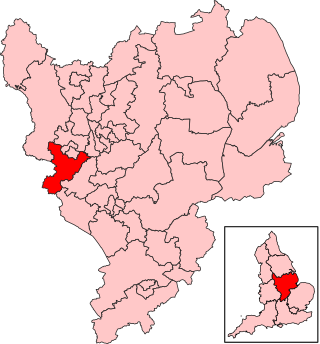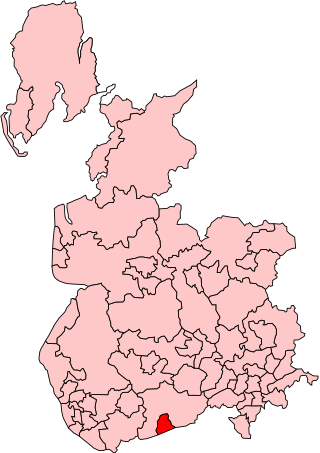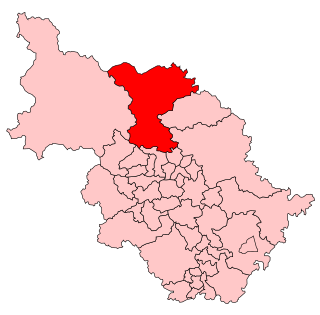
Blackburn is a constituency in Lancashire, England, which is represented in the House of Commons of the UK Parliament by independent politician Adnan Hussain. From 2015 to 2024 it was represented by Kate Hollern of the Labour Party and, from 1979 to 2015, by Jack Straw who served under the Labour leaders of Neil Kinnock and John Smith and the Labour governments of Tony Blair and Gordon Brown.

Berwick-upon-Tweed was a parliamentary constituency in Northumberland represented in the House of Commons of the UK Parliament from 2015 until its abolition for the 2024 general election by Anne-Marie Trevelyan, a Conservative.

South Derbyshire is a constituency represented in the House of Commons of the UK Parliament since 2024 by Samantha Niblett of the Labour Party.

Lancaster was a constituency of the House of Commons of the Parliament of England then of the Parliament of Great Britain from 1707 to 1800 and of the Parliament of the United Kingdom from 1801 to 1867, centred on the historic city of Lancaster in north-west England. It was represented by two Members of Parliament until the constituency was disenfranchised for corruption in 1867.

North Cheshire is a former United Kingdom parliamentary constituency. It was created upon the division of Cheshire in 1832. In 1868 it was abolished with South Cheshire to form East Cheshire, Mid Cheshire, West Cheshire and Stalybridge.
Derby is a former United Kingdom Parliamentary constituency. It was a constituency of the House of Commons of the Parliament of England, then of the Parliament of Great Britain from 1707 to 1800 and of the Parliament of the United Kingdom from 1801 to 1950. It was represented by two members of parliament. It was divided into the single-member constituencies of Derby North and Derby South in 1950.
East Derbyshire was a parliamentary constituency in Derbyshire which elected two Members of Parliament to the House of Commons of the Parliament of the United Kingdom.

Warrington was a parliamentary constituency in the United Kingdom. From 1832 to 1983 it returned one Member of Parliament (MP) to the House of Commons of the Parliament of the United Kingdom.

Ripon was a constituency sending members to the House of Commons of England, Great Britain and the House of Commons of the Parliament of the United Kingdom until 1983, centred on the city of Ripon in North Yorkshire.
Rye was a parliamentary constituency centred on the town of Rye in East Sussex. It returned two Members of Parliament to the Parliament of England before 1707, Parliament of Great Britain until 1801 and the House of Commons of the Parliament of the United Kingdom until its representation was halved under the Reform Act 1832.
Lambeth was a constituency 1832—1885 loosely equivalent in area to the later administrative units: the London Borough of Lambeth and the south-west and centre of the London Borough of Southwark. It returned two members of parliament (MPs) to the House of Commons of the UK Parliament by the bloc vote version of the first-past-the-post system.

East Norfolk was a constituency in the county of Norfolk that returned two members of parliament to the House of Commons of the Parliament of the United Kingdom from 1832 until 1868. It was re-established in 1885 with representation of one member. That seat was abolished in 1950.

North Lincolnshire, formally known as the Northern Division of Lincolnshire or as Parts of Lindsey, was a county constituency in the Lindsey district of Lincolnshire. It returned two Members of Parliament (MPs) to the House of Commons of the Parliament of the United Kingdom.

West Cornwall was a county constituency in the House of Commons of the Parliament of the United Kingdom. It elected two Members of Parliament (MPs) by the bloc vote system of election.

East Cumberland is a former county constituency in the House of Commons of the Parliament of the United Kingdom. It elected two Members of Parliament (MPs) by the bloc vote system of election.
Northern West Riding of Yorkshire was a parliamentary constituency covering part of the historic West Riding of Yorkshire. It returned two Members of Parliament (MPs) to the House of Commons of the Parliament of the United Kingdom, elected by the bloc vote system.
Kingston upon Hull, often simply referred to as Hull, was a parliamentary constituency in Yorkshire, electing two members of parliament to the Parliaments of England, Great Britain and House of Commons of the Parliament of the United Kingdom, from 1305 until 1885. Its MPs included the anti-slavery campaigner, William Wilberforce, and the poet Andrew Marvell.

South Lincolnshire, formally called the Southern Division of Lincolnshire or Parts of Kesteven and Holland, was a county constituency in Lincolnshire. It returned two Members of Parliament (MPs) to the House of Commons of the Parliament of the United Kingdom, elected by the bloc vote electoral system.
Tynemouth and North Shields was a parliamentary borough constituency represented in the House of Commons of the Parliament of the United Kingdom between 1832 and 1885. It elected one Member of Parliament (MP) by the first-past-the-post system of election.
William Pole Thornhill was a British Whig and then Liberal Party politician. He sat in the House of Commons from 1853 to 1865.








